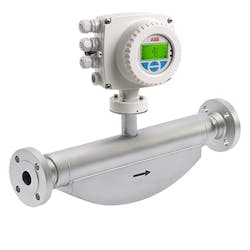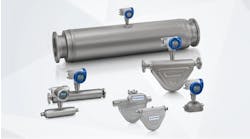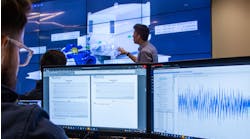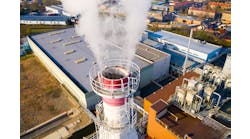Flow is fundamental to the operation of any chemical plant. The newest kid on the block, relatively speaking, is Coriolis flow metering — it first appeared on the scene 35 years ago. Coriolis flowmeters not only address their own performance but also track broader process issues and deliver improvements across plant operations.
To understand all the benefits of Coriolis flowmeters and the robust information they provide, Chemical Processing spoke with Vanessa Klekar, U.S. technical sales specialist manager, Flow Products, at ABB Measurement & Analytics.
Q: What was used before Coriolis flowmeters?
A: Mechanical, electromagnetic and differential pressure (DP) flowmeters. There were many issues with mechanical meters — including parts that wear out, causing downtime and high maintenance costs. With DP, you have limitations in accuracy. The big advantage with Coriolis meters is they provide direct mass flow measurement.
Q: What makes Coriolis flowmeters more accurate?
A: It’s mainly the principle of operation. You have vibrating tubes and any flow going through the tubes generate a phase shift between the inlet and the outlet of the meter. It’s almost 10 times more accurate than the older technologies. And the whole principle is directly related to mass flow instead of volume flow. You get an additional benefit for accuracy by getting rid of any kind of pressure and temperature compensation or by recalculating any volume flow measurements into mass flow.
The Coriolis meter is a direct mass measurement and it also measures the density directly. And in many chemical applications, the density of the product is directly related to quality. It’s not just the accuracy, it’s also improving performance.
Q: Can you explain the different Coriolis designs?
U.S. Technical Sales Specialist Manager, Flow Products ABB Measurement & Analytics
A: Coriolis meters come with a little bit of a difference in their design, especially the mechanical part of it. There are larger, U-shaped designs and slightly bent tube design like ABBs. You also have straight tube designs. And they all have pros and cons. But I would say most of the Coriolis meter designs have developed into dual-tube design. This means the process flow is equally split between the slightly bent tubes when going through the meter. This design has proven to provide a very high accuracy, reliable measurement with little sensitivity to challenging process conditions, or installation effects.
Q: What are they best used for?
A: Anywhere you need accurate measurement. Coriolis meters are used in measurement of ingredients going into reactors to ensure the proper mixture and a safe chemical process. Some ingredients are really expensive, so our customers need accurate measurement to meet a quality specification while minimizing the use of the most expensive components. And so that’s where accurate measurement truly becomes important. Coriolis meters are also used after the batching process to measure the mixture of products. This is where density measurements indicate quality.
They’re also used in measuring the gas that is going to incinerators and exhaust systems for environmental compliance. Coriolis meters have a built-in verification, therefore, they provide users confidence in their performance while minimizing downtime. If you need to verify that the meter is performing within its stated accuracy, these verifications do this. Therefore, you don’t have to take the downtime to remove the meter, take it to a lab to get it calibrated. The online diagnostics can do that for you.
Some recent applications also are in custody transfer when you’re loading a truck or a barge. It’s popular because of their accuracy and the fact that you can measure in pounds; in mass and you don’t have to account for the change of temperature and pressure on the volume of the product itself.
Q: What needs to be considered when selecting Coriolis meters?
A: Things such as flow rate, density and process fluid need to be considered to make sure the tube material is compatible with the chemical and process conditions. Temperature is also important.
There may be some things we need to do like remote mount transmitters, if it’s going to be a really high temperature. Pressure needs to be considered as well, it is critical that the process connections and tubes are rated to meet the design requirements.
Also, how accurate does it need to be? There are different tiers of Coriolis meters in our offering. If this isn’t a custody use, maybe a utility meter will do; in the competitive petrochemical industry, these product tiers allow customers to get the benefits of Coriolis technology without paying the price for the highest level accuracy.
With no up or downstream piping requirements the compact Coriolis flowmeters can be installed in the tightest spaces, enabling applications not possible before.
Q: Is there ever a case where a Coriolis meter is not required or the best choice?
A: There are definitely places where a Coriolis meter is overkill. If you just need a general idea of what’s going on or an indication that there’s some type of flow happening in the line, you wouldn’t need a Coriolis meter. If you put a Coriolis meter at every measurement point, you could definitely build a chemical plant so expensive that you would price yourself out of the market.
Coriolis meters are also limited in size. If you have a really large pipeline, a Coriolis meter wouldn’t work. Another area where you don’t use Coriolis is steam measurement. Or for simple water — freshwater or wastewater treatment plants usually don’t use a Coriolis simply because it would be overkill.
Q: What about fluid factors like entrained bubbles?
A: At ABB we have done a lot of research in that area. We think it’s one thing to specify accuracy in the data sheet in lab situations, but it’s another thing to increase the accuracy when it really counts in the field. And gas bubbles are one of the most frequent reasons why Coriolis meters have additional errors or do not meet their accuracy specs. We have come out with a new solution called Enhanced Coriolis Control (ECC.) The software puts intelligence into the meter to control the vibration of the tubes in a much better way and countering any effect coming from gas bubbles; by doing so, this increases the accuracy significantly. And the great thing is it’s not something mechanical or hardware related.
It’s simply software. And by applying the latest algorithms coming from research into that controlling area, you can gain a lot of benefits and a lot of accuracy.
For older meters, you simply need to update the firmware of the meter.
Q: What sort of issues can Coriolis meters detect?
A: The whole density feature is like a built-in analyzer into a flowmeter with all the benefits that come with it. You can measure concentrations. You can control online the recipe of a chemical mixture. The other point, of course, is that with these vibrating tubes, Coriolis meters can provide you with so much data from the process that you can detect sediments or you can detect abrasion to the tubing, any kind of coating, any kind of gas phases. You can detect gas bubbles in a way that you can prevent pumps from running dry. Looking at instrumentation in general, there’s hardly any other device where you can get more data. And that provides you with a window into the process. For example, if a valve is not closing down 100%, you can see that from the data of a Coriolis meter. You have to know how to look for it and how to interpret the data, but there is a lot of potential.
Q: Are there maintenance issues to consider?
A: If you have any kind of corrosion, erosion or coating issues with the tubes, you need to be careful that the tubes are fit for the purpose and that they are not affected by the application. Most manufacturers, ABB included, provide some sort of software solution that monitors the health status of the meter.
We like to be involved with applications upfront because there are some things that we can recommend. If you have a highly abrasive fluid, we would want to recommend keeping the velocity down to a certain level in the meter.
So maybe you would go a meter size up. As far as general maintenance, these meters truly are as close to maintenance-free as you can get. They don’t have moving parts that wear and tear.
If you can prevent anything affecting the tubes, the lifespan is pretty long.
For more information, email Vanessa Klekar at [email protected] or visit www.abb.com/coriolis.





